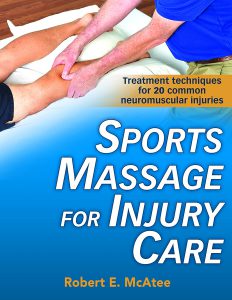
Enable your clients and patients to get back in the game and live pain free after injury. In Sports Massage for Injury Care, experienced sports therapist Bob McAtee explains the types of soft tissue injury most common in sport and explains why manual therapy is so valuable in treating musculoskeletal injuries.
Available from Human Kinetics
No two injuries are the same. Whether an injury is acute or chronic, you need to understand and treat the underlying cause so you don’t leave your athletes susceptible to re-injury. Sports Massage for Injury Care emphasizes the importance of accurate assessment and evaluation, and focuses on 20 of the most common neuromuscular injuries seen in athletes. For each featured injury, there are assessment recommendations, treatment options and injury-specific protocols, and self-care options for when the athlete is not on the treatment table.
Learn the evidence behind the techniques that are most effective, based on clinical research. Each treatment protocol is presented with vivid full-color photos and step-by-step instructions. Detailed anatomical illustrations show you the muscles, joints, and soft tissues involved. Practitioner examples and case studies give you a glimpse into how other practicing professionals use the techniques to help their clients heal quicker and more fully.
Clinical sports massage therapy is often the missing component in injury-rehabilitation programs. With Sports Massage for Injury Care, you have the ultimate practical resource for relieving pain and getting your clients and patients back to their athletic endeavors and daily activities as quickly as possible.
CE exam available! For certified professionals, a companion continuing education exam can be completed after reading this book. The Sports Massage for Injury Care Online CE Exam may be purchased separately or as part of the Sports Massage for Injury Care With CE Exam package that includes both the book and the exam.
Audience
Practical reference for experienced sport massage therapists, sport physicians, physiotherapists, manual therapists, and athletic trainers.
Video Example of Broad Cross-Fiber Strokes.
Broad cross-fiber massage strokes, also known as muscle broadening or cross-fiber fanning, are administered perpendicularly to the long axis of the muscle and can be administered to just about any muscle, but are especially effective on the larger muscles of the hips, legs, arms, and back. Broad cross-fiber strokes stretch and separate the muscle fibers, with the intention of helping to prevent the formation of adhesions within and between muscles and fascial layers. When bands of muscle fibers feel ropey during muscle broadening, extra attention is given to that section of the muscle belly to restore the ability of the fibers to spread apart.
Video Example: Deep Transverse Friction for Treating Achilles Tendinopathy
Transverse friction is an excellent intervention for treating acute, subacute, and
chronic muscle and tendon strains and ligament sprains. The intent of transverse
friction treatment is to reduce pain, to promote the orderly formation of functional
scar tissue by breaking cross-linked adhesions and stimulating increased fibroblast
activity, and to encourage more complete healing of soft tissue injuries.
Table of Contents
Part I. Foundational Knowledge
Chapter 1. Concepts and Principles
The Process of Clinical Reasoning
Pain Science
Chapter 2. Reviewing Soft Tissue Types
Connective Tissue
Fascia
Ligaments
Tendons
Muscles
Nerves
Chapter 3. Principles of Assessment
HOPS Method
Assessing Active, Passive, and Resisted Motion
Additional Tests
Perpetuating Factors
Part II. A Closer Look at Injury and Repair
Chapter 4. Soft Tissue Injury
Acute Injuries
Chronic Injuries
Soft Tissue Injury Repair Process
Chapter 5. Soft Tissue Techniques
Compressive Effleurage
Compressive Petrissage
Broad Cross-Fiber Stroke
Longitudinal Stripping
Pin-and-Stretch Techniques
Isolytic Contractions
Deep Transverse Friction
Facilitated Stretching
Part III. Common Neuromuscular Injuries
Chapter 6. Treatment of Lower-Extremity Soft Tissue Injuries
Achilles Tendinopathy
Lateral Ankle Sprain
Groin Strain
Hamstring Tendinopathy
Iliotibial Band Syndrome (ITBS)
Medial Collateral Ligament (MCL) Sprain
Patellar Tendinopathy
Peroneal (Fibularis) Tendinopathy
Plantar Fasciitis/Fasciopathy
Shin Splints
Chapter 7. Treatment of Upper-Extremity Soft Tissue Injuries
Rotator Cuff
Tennis Elbow
Golfer’s Elbow
Bicipital Tendinopathy
Chapter 8. Sports Massage for Nerve Entrapment Syndromes
Quadrilateral Space Syndrome (QSS)
Thoracic Outlet Syndrome (TOS)
Carpal Tunnel Syndrome (CTS)
Cubital Tunnel Syndrome
Tarsal Tunnel Syndrome
Piriformis Syndrome (PS)